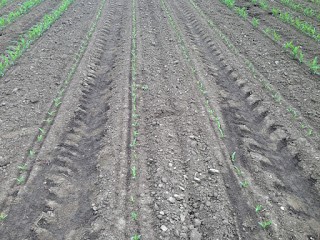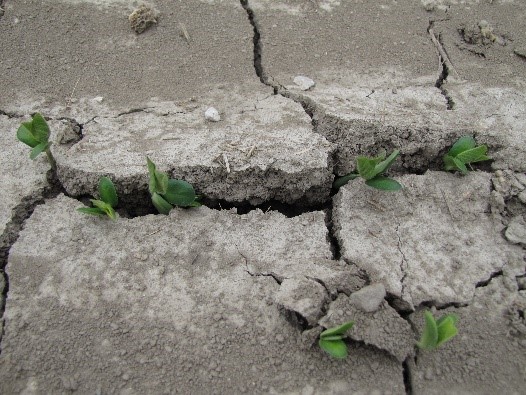Every meeting this winter presenters talked about planting soybeans early. We must remember that the first major factor in raising any crop is the soil conditions at planting time, not what the calendar says. To ensure the crop gets off to the best start possible, seed should be planted into good soil conditions.
We want all the plants to come up within 24 (if not 12) hours of each other under ideal emergence environments. Otherwise, plants that emerge later than the rest of the stand will struggle to catch up and will effectively be sapping nutrients and resources away from plants around them, which are farther along in development. These same plants will become ‘runts’ and produce less yield.
Below are some common issues associated with trying to plant in improper soil conditions.
Soil Compaction: Trying to get fieldwork done when the field
 |
| 1Source: Farms.com |
is too wet can lead to compaction issues. Wet, saturated soil is prone to compaction, which can lead to many issues with crop growth and development. Compacted soils may reduce seedling germination and emergence, as well as limit root growth and nutrient uptake. The average weight of farm equipment today continues to increase and can cause yield limiting compaction and uneven stands, especially in wet field conditions.
Planter row units can compact the side walls of the seedbed, restricting root growth and causing mohawked roots if the soil is too wet at the time of planting. Most of the compaction occurs on the first pass and working fields to “dry them out” creates a compaction layer that can last all year. Additionally, with growers farming increasingly more acres, in the rush to plant they can be tempted to enter fields too early.
Increasing soil aggregation, reducing bulk density and increasing porosity and organic matter content, along with only being on the field when conditions are dry enough, are the best ways to reduce compaction.
Soil Crusting: Low organic matter soils that are weakly aggregated
 |
| 2Source: Field Crop News |
may be prone to surface crusting as they dry out. This can cause issues with emergence, especially with soybeans. The soybean hypocotyl can potentially break when pushing against the crusted layer. And a broken hypocotyl is fatal for a soybean plant.
A primary reason for crusting is rain compacting the surface of the soil along with accumulation of soil ‘fines’ from excessive tillage. Keeping plant residues on the soil will reduce the impact force from rain drops and help prevent crusting. No-till, cover-cropping or adding manure can help increase organic matter and improve soil aggregation. Also, increased biological activity from earth worms and their casts will help the soil resist crusting. Using a rotary hoe if the soil has crusted can help break up the crusted layer and allow plants to grow normally, however this can also displace seedlings from the soil and reduce your stand.
To ensure seedbed conditions are right, don’t enter a field until the soil is moist yet crumbly and plan your farming activities to reduce risk of compaction and crusting.






 and then
and then